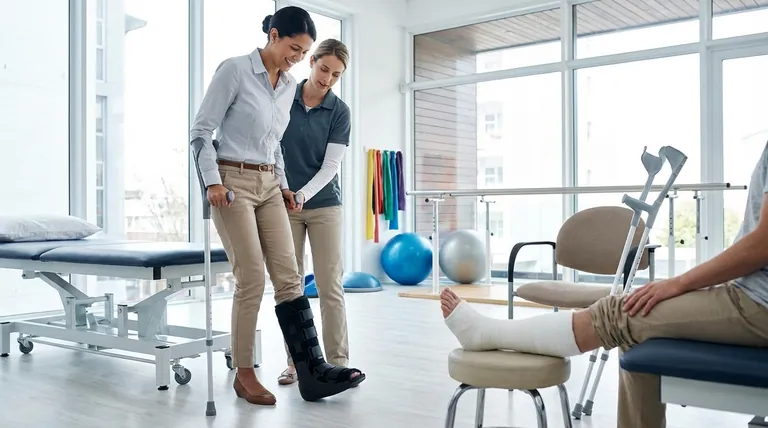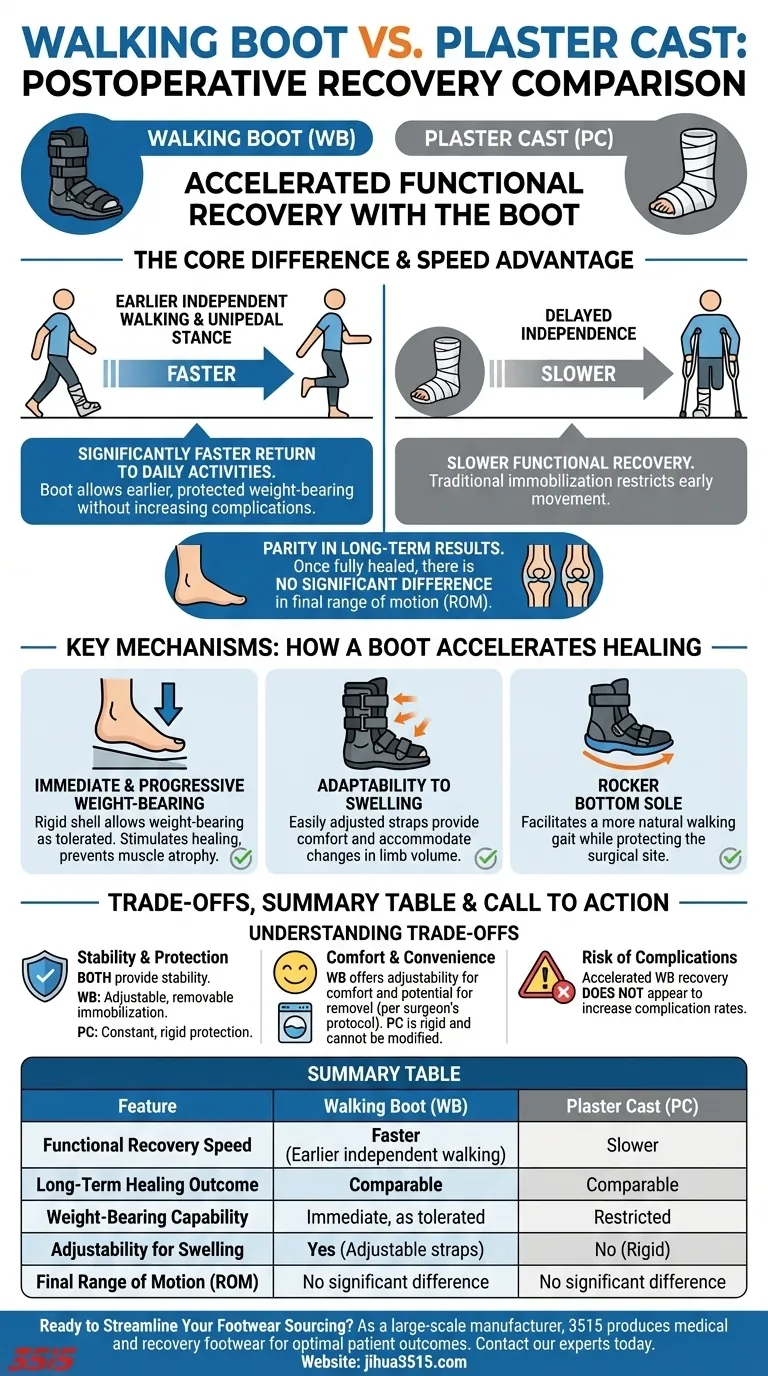For postoperative recovery, a walking boot (WB) generally facilitates a significantly faster return to daily activities than a traditional plaster cast (PC). While both methods achieve similar long-term healing outcomes, the boot is engineered to allow for earlier, protected weight-bearing, which accelerates the functional recovery process without increasing complication rates.
The choice between a walking boot and a plaster cast is not about the final destination—both lead to comparable long-term healing. Instead, it's about the journey; the boot offers a faster, more functional path to recovery without compromising the stability of the surgical site.

The Core Difference: Functional Recovery vs. Final Outcome
The primary advantage of a walking boot is its impact on the speed of your recovery, not the final result. Understanding this distinction is key to making an informed decision.
Defining Functional Recovery
Functional recovery refers to your ability to perform essential daily movements. This includes critical milestones like standing on one leg (unipedal stance) or walking without the assistance of crutches.
The Speed Advantage of the Walking Boot
Studies show a clear and significant difference here. Patients using a walking boot are able to stand independently and walk without crutches much sooner than those immobilized in a plaster cast.
Parity in Long-Term Results
Crucially, this accelerated timeline does not come at the expense of the final outcome. Once fully healed, there is no significant difference in the final range of motion (ROM) between patients who used a boot and those who used a cast.
Key Mechanisms: How a Boot Accelerates Healing
The walking boot's design incorporates specific features that enable a faster return to mobility while still protecting the healing tissue.
Immediate and Progressive Weight-Bearing
The rigid shell and supportive structure of a boot allow for immediate weight-bearing as tolerated. This controlled loading stimulates healing and helps maintain muscle tone, preventing the atrophy commonly seen with prolonged non-weight-bearing in a cast.
Adaptability to Swelling
Postoperative swelling is inevitable. A walking boot can be easily adjusted with straps, providing comfort and accommodating changes in limb volume. A plaster cast is rigid and cannot be modified, which can lead to discomfort.
The Role of the Rocker Bottom Sole
Most walking boots feature a rocker bottom design. This curved sole facilitates a more natural walking gait while minimizing motion at the affected joint, effectively protecting the surgical repair during ambulation.
Understanding the Trade-offs and Considerations
While the evidence points toward the boot for faster recovery, it's important to understand the complete picture.
Stability and Protection
Both the boot and the cast are designed to provide stability and protect the surgical site. The key difference is that the boot achieves this with adjustable, removable immobilization, whereas the cast provides constant, rigid protection.
Comfort and Convenience
The ability to adjust the boot for comfort is a significant advantage. Furthermore, depending on the surgeon's protocol, it may be removed for cleaning or during rest, which is not an option with a plaster cast.
Risk of Complications
The accelerated recovery associated with a walking boot does not appear to increase complication rates. The controlled motion and protection offered by the boot are sufficient to ensure stability and promote proper healing.
Making the Right Choice for Your Goal
Your personal recovery priorities should guide the conversation with your surgeon.
- If your primary focus is a rapid return to independence and daily activities: The walking boot is the superior choice, enabling you to walk without crutches sooner.
- If your primary focus is ensuring maximum long-term healing and range of motion: Both the walking boot and plaster cast deliver comparable final outcomes.
- If your primary focus is comfort and managing postoperative swelling: The adjustability of a walking boot makes it a more practical and comfortable option than a rigid plaster cast.
Ultimately, the evidence points to the walking boot as a modern tool that streamlines the recovery journey without sacrificing the quality of the final result.
Summary Table:
| Feature | Walking Boot (WB) | Plaster Cast (PC) |
|---|---|---|
| Functional Recovery Speed | Faster (earlier independent walking) | Slower |
| Long-Term Healing Outcome | Comparable | Comparable |
| Weight-Bearing Capability | Immediate, as tolerated | Restricted |
| Adjustability for Swelling | Yes (adjustable straps) | No (rigid) |
| Final Range of Motion (ROM) | No significant difference | No significant difference |
Ready to Streamline Your Footwear Sourcing?
As a large-scale manufacturer, 3515 produces a comprehensive range of footwear for distributors, brand owners, and bulk clients. Our production capabilities encompass all types of shoes and boots, including specialized medical and recovery footwear designed for optimal patient outcomes. Let us help you bring high-quality, functionally superior products to your market.
Contact our experts today to discuss your manufacturing needs and discover how we can add value to your supply chain.
Visual Guide

Related Products
- Safety Footwear Wholesale Manufacturer for Custom OEM/ODM Production
- Premium Grain Leather Safety Boots for Bulk Supply
- Customizable Anti-Smash Safety Boots for Wholesale & Private Label Manufacturing
- Premium Wholesale Wheat Nubuck Safety Boot with Rapid Lacing System
- Custom Wholesale Leather Safety Boots Direct Factory Manufacturing
People Also Ask
- Is safety-toe as good as steel toe? Choose the Right Protection for Your Job
- What cultural and environmental considerations are tied to wearing shoes indoors? Balance Hygiene, Tradition, and Foot Health
- Do snake bite boots work? Your Ultimate Guide to Effective Snake Bite Protection
- What do heavy duty boots do? Protect Your Feet in Demanding Work Environments
- What are the cultural perspectives on wearing shoes in the house? A Guide to Home Etiquette & Hygiene



















